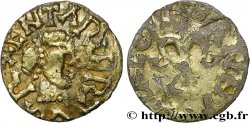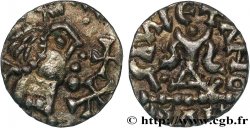v32_0980 - MEROVINGIAN COINAGE - BANASSAC (BANNACIACO) - Lozere Triens avec deux croix et deux globules
MONNAIES 32 (2007)
Starting price : 2 500.00 €
Estimate : 3 500.00 €
Realised price : 2 950.00 €
Number of bids : 3
Maximum bid : 3 300.00 €
Starting price : 2 500.00 €
Estimate : 3 500.00 €
Realised price : 2 950.00 €
Number of bids : 3
Maximum bid : 3 300.00 €
Type : Triens avec deux croix et deux globules
Date: (VIIe siècle)
Mint name / Town : Banassac
Metal : gold
Diameter : 12,6 mm
Orientation dies : 9 h.
Weight : 1,28 g.
Rarity : R3
Coments on the condition:
Magnifique monnaie bien frappée sur un flan en bon or. Bons reliefs et bon centrage, avec toutes les légendes et tous les détails visibles. Une infime rayure est à signaler devant le visage entre les deux croisettes
Catalogue references :
Predigree :
Cet exemplaire a été acheté chez Burgan en 1990
Obverse
Obverse legend : ANÉPIGRAPHE.
Obverse description : Tête barbare diadémée, à droite ; diadème et cou perlés ; deux croisettes et deux globules alternés devant le visage.
Reverse
Reverse legend : GAVALETANO // BAH.
Reverse description : Calice à deux anses, posé sur une ligne d’exergue perlée.
Commentary
Les triens de ce type sont attribués à SIGEBERT et sont relativement abondants ce qui a permis d'en réaliser une étude précise, avec des différenciations parfois subjectives ! Cet exemplaire appartient à la série L, "Avec deux croix et deux globules" ; un seul triens de ce type figure dans le Belfort sous le n° 763, en signalant un exemplaire à la BN et un autre au musée de Metz.








 Report a mistake
Report a mistake Print the page
Print the page Share my selection
Share my selection Ask a question
Ask a question Consign / sell
Consign / sell
 Full data
Full data